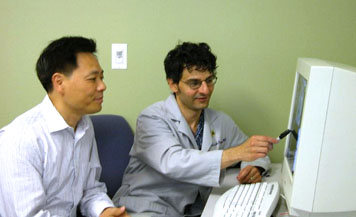Small Animal MRI Scanner Will Enhance Research Efforts
 Researchers at the Feinberg School of Medicine will have enhanced imaging capabilities thanks to a $2 million grant from the National Institutes of Health High End Instrumentation (HEI) grant program. The funding will be used to purchase a 7T Bruker ClinScan MRI scanner, which provides high-resolution in vivo anatomic and functional MR scanning of small animals such as mice, rats, and rabbits.
Researchers at the Feinberg School of Medicine will have enhanced imaging capabilities thanks to a $2 million grant from the National Institutes of Health High End Instrumentation (HEI) grant program. The funding will be used to purchase a 7T Bruker ClinScan MRI scanner, which provides high-resolution in vivo anatomic and functional MR scanning of small animals such as mice, rats, and rabbits.
Debiao Li, PhD, director of cardiovascular MRI research in the Department of Radiology, the principal investigator of the HEI proposal, also is a professor of radiology and biomedical engineering and collaborated extensively with faculty across Northwestern University in submitting the proposal. “This was a multidisciplinary effort,” he says. “In particular, I want to extend great appreciation for the key roles played by Reed Omary, MD, vice chair of research for radiology and associate professor of radiology and biomedical engineering; Mark Wainwright, MD, PhD, associate professor of pediatrics; John Disterhoft, PhD, Ernest J. and Hattie H. Magerstadt Memorial Research Professor of Physiology; David Johnson, PhD, associate dean for research operations; and Douglas Losordo, MD, Eileen M. Foell Professor of Heart Research and director of Feinberg Cardiovascular Research Institute. We would also like to acknowledge the support of Eric Russell, MD, Drs. Frederick John Bradd and William Kennedy Professor of Radiology and chair of the Department of Radiology; and Feinberg School Dean J. Larry Jameson, MD, PhD, for this application.”
The new scanner will be the first MRI unit on the downtown campus dedicated to small animal imaging. It will be located in the Department of Radiology’s Center for Advanced Magnetic Resonance Imaging (CAMRI) and will complement the already existing 1.5T and 3T clinical Siemens MRI scanners. The scanner will be operated through a combined effort of the Department of Radiology and the Feinberg School.
Dr. Li explains that the new 7T MRI scanner is expected to be used primarily in imaging animal models of cardiovascular, neurologic, and oncologic disease. While there are a number of expected major users with existing R01 funding, any researcher within or outside the Northwestern community will be able to sign up for scanner time. This time will be allotted for researchers who require the assistance of an MRI technologist, as well as for those who have the training to perform scanning themselves. “The scanner is expected to be ‘turnkey,’ thereby permitting large throughput imaging,” Dr. Li says.
The new scanner will have a Siemens operating system. The clinical MRI scanners at Northwestern Memorial Hospital, as well as the research MRI scanners at CAMRI, are all Siemens scanners. Additionally Siemens has provided five basic scientists within the Department of Radiology as part of a 10-year research agreement with Northwestern University. “This 7T scanner is the only dedicated small animal MRI that has the same operating system as existing clinical scanners,” says Dr. Omary. “Thus, innovative imaging techniques developed in animal models on the 7T scanner can be readily translated to the clinical MRI scanners. Northwestern is one of only a handful of institutions worldwide to have this opportunity to directly translate preclinical imaging studies in this way.”
A number of ongoing research studies will benefit from this new technology. They include NIH-funded research projects led by Dr. Disterhoft that focus on the cellular and subcellular mechanisms of learning in the young and aging brain. His team is studying neurobiology of associative learning in the mammalian brain at cellular and systems levels using both in vivo and in vitro techniques. An important interest in this research program is examination of the cellular mechanisms for altered learning in aging. They are using a combination of behavioral, biophysical, and pharmacological approaches to address this question. Functional MRI is being used as an important systems-level tool to visualize the neural circuits that mediate eyeblink conditioning. Most of these experiments are done with animals and in collaboration with colleagues at distant locations because of the unavailability of the high-field magnet needed. While collaboration with colleagues outside of the Feinberg School is valuable in many ways, doing experiments in a distant place is not a formula for making rapid progress. “The presence of the new 7T scanner will be a huge benefit for many research programs in the medical school,” Dr. Li says.
Dr. Li says the scanner is expected to arrive in late summer, 2009. For more information, contact Dr. Li at d-li2@northwestern.edu or Dr. Omary at reed@northwestern.edu.






